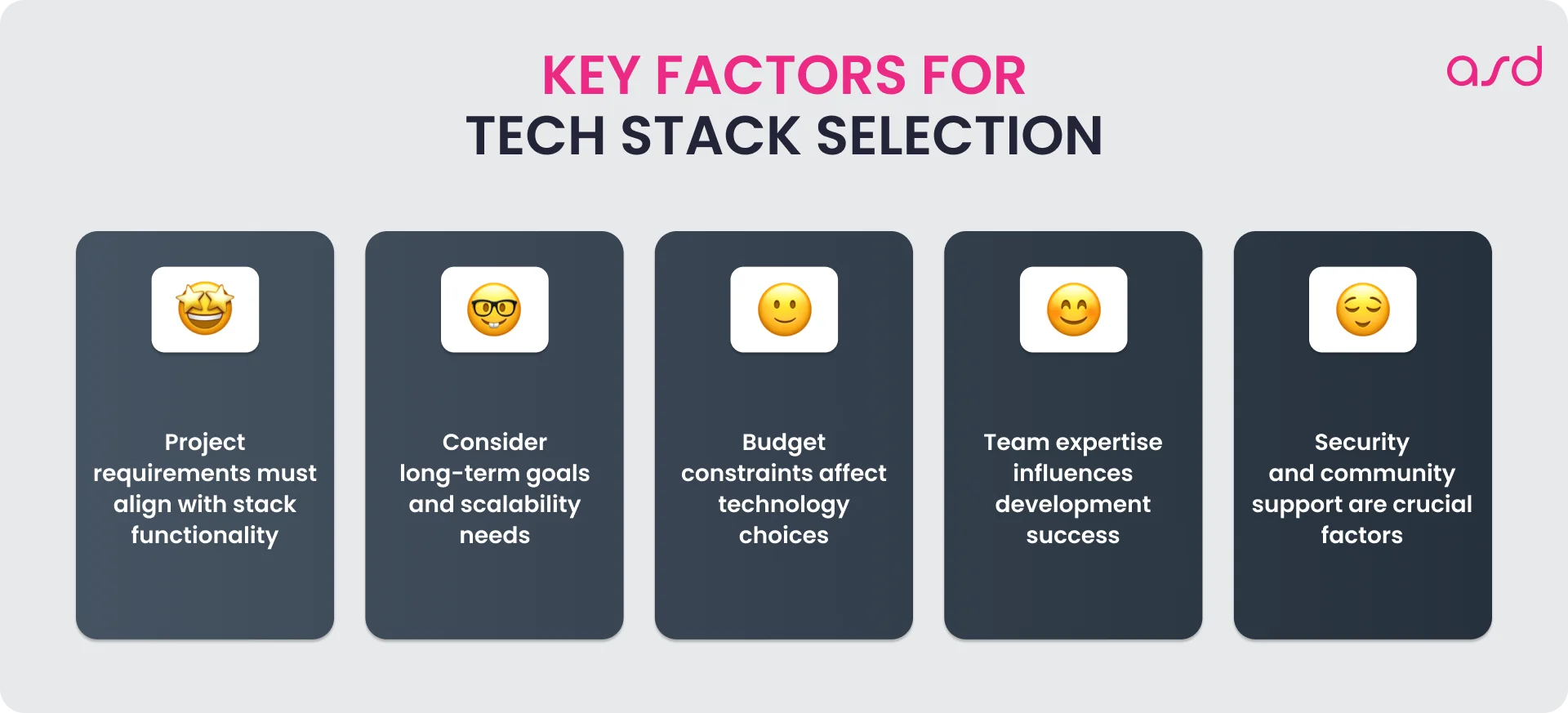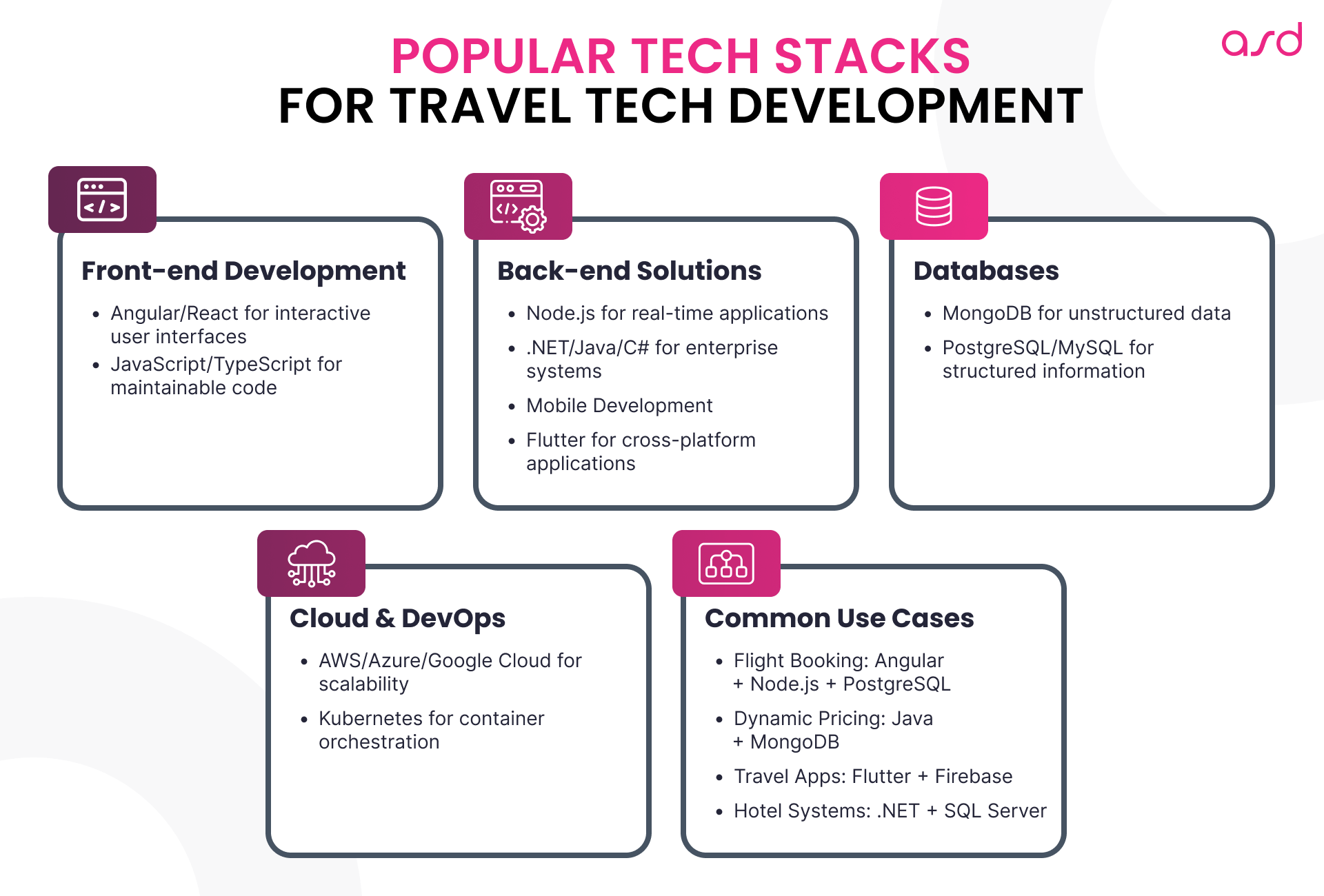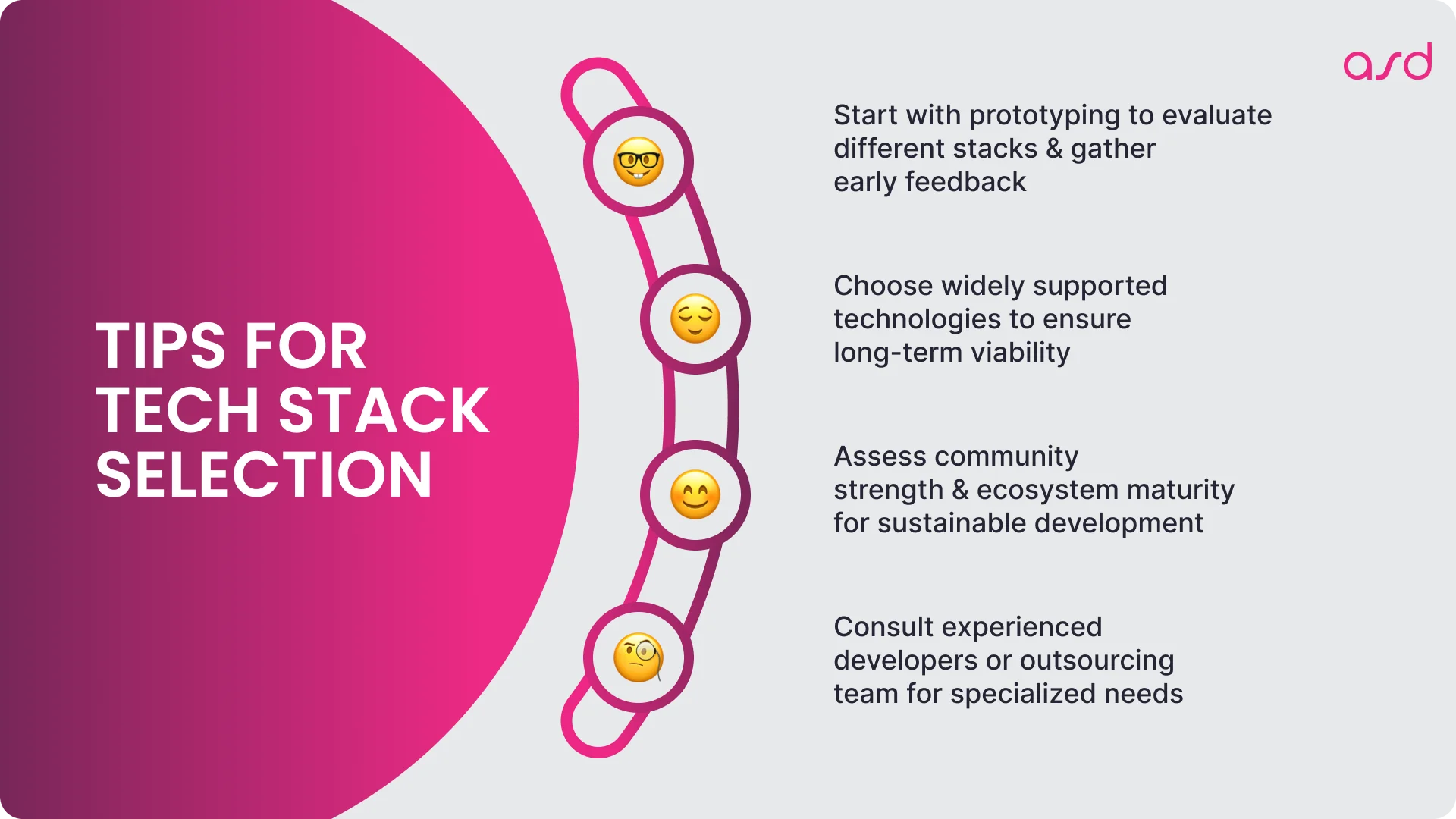Table of Content
- Understanding Technology Stacks
- Key Factors to Consider When Choosing a Tech Stack
- Benefits of a Well-Chosen Tech Stack
- Popular Tech Stacks for Travel Tech Development in 2026
- Emerging Technologies and Trends
- Practical Tips for Selecting Your Tech Stack
- Our Tech Stack: Built for Travel Tech Innovation
- Summary
Let’s choose the perfect tech stack for your travel project
Book a callWhen you build your house first thing you must do is lay a foundation (even in OTA vs booking engine kinds of situations). If in the house the foundation: footing, wall, slab, pier, pile, — then in the web development is tech stack. And in the spirit of its analogy, your tech stack will be base of your project, it will define the future of your project and how steady and timeproof it will be.
This article will help you navigate the numerous options by exploring key factors, including how to choose a tech stack for web development, such as project requirements, team expertise, and budget constraints. We’ll also look at popular tech stacks and offer practical tips to assist you in making an informed decision.
Key Takeaways
- Choosing the right tech stack is essential for functionality, scalability, and maintainability in travel product development.
- Key factors for selecting a tech stack include project requirements, team expertise, budget, and security considerations.
- Prominent tech stacks for 2026 include those built with Angular, React, Node.js, and .NET, which are widely used for scalable and maintainable solutions. These stacks often leverage JavaScript, TypeScript, PHP, Java, and C# for back-end development, paired with databases like MongoDB, PostgreSQL, and Microsoft SQL Server. For mobile development, Flutter and Capacitor.js are popular choices, while DevOps practices commonly rely on AWS, Azure, Google Cloud, Kubernetes, and CI/CD pipelines for efficient deployment and scalability.
Understanding Technology Stacks
A tech stack consists of an aggregation of technologies used for creating and maintaining software. It typically consists of frontend and backend components, each playing a pivotal role in ensuring the efficiency, speed, and reliability of the software. In the client-server model, software applications are divided into client-side (frontend) and server-side (backend) components. This separation allows for a more organized development process, with each part being able to focus on its specific functionalities. The technology stack and web app technology stack are essential for understanding how these components interact.
Choosing the right tech stack is crucial as it affects the functionality, maintainability, and scalability of your application. The core components of a web application include both the frontend and backend, which must work together seamlessly to provide a smooth user experience. Understanding these components helps in making informed decisions about your tech stack. Opting for a popular tech stack, such as MongoDB or Flutter, can enhance performance, user experience, and attract skilled developers, while also providing access to a broader range of tools and services.
Frontend Tech Stack Components
The frontend tech stack determines the look and feel of your web application. Core technologies in this stack include HTML, CSS, and JavaScript, which are foundational for building user interfaces. These technologies are essential for creating the structure, style, and interactivity of web pages.
Popular frameworks used in frontend development, such as React, Angular, and Vue.js, help build interactive and dynamic user interfaces. These frameworks and libraries enhance the user experience by making web applications more responsive and engaging. For instance, React’s component-based architecture allows for reusable UI components, improving development efficiency.
The performance of your frontend tech stack is critical for user experience. Optimizing front-end components ensures that your web application loads quickly and runs smoothly, keeping users satisfied. Selecting the appropriate tech stack for your frontend is crucial for delivering a high-quality user interface.
Backend Tech Stack Components
The backend tech stack is responsible for the server-side operations of your web application. Popular backend programming languages include Python, Ruby, Java, JavaScript, PHP, and Dart. These languages provide the foundation for building robust and scalable server-side applications.
Frameworks like Django and Express.js offer structure and support for backend development, making it easier to manage server-side operations. These frameworks simplify the development process by providing ready-to-use components and tools. For example, Django, a high-level Python framework, follows the “batteries-included” philosophy, offering many built-in features for rapid development.
Databases play a crucial role in the backend tech stack, acting as central repositories for storing and managing data. Choosing the right database technology is essential for ensuring data integrity and performance. Popular choices include MySQL, which is frequently used for online applications and APIs due to its reliability and simplicity.
Informed choices about backend technologies are vital for your web application’s overall performance.
Want a reliable full-stack team to do your project?
Key Factors to Consider When Choosing a Tech Stack
Selecting a tech stack requires careful consideration of multiple factors. The chosen tech stack must align with the specific functionality and features required by the project. Balancing project requirements, long-term goals, and budget constraints ensures a successful outcome.
Selecting the wrong tech stack can increase development time, costs, and performance issues, so weighing all factors carefully is important. The following subsections will delve into specific considerations, including project requirements, scalability, team expertise, budget, time to market, security, and community support.
Project Requirements
Your project’s specific requirements serve as the starting point for selecting a tech stack. Considering the depth and intricacies of the project along with future scalability needs is important, for instance, do you need to integrate generative AI into your travel project, details matter. For instance, if your travel app needs to handle complex business logic and integrate multiple APIs, you’ll need a robust and flexible tech stack.
Let the application’s complexity and desired functionality guide your tech stack selection. Simpler projects might only require a monolithic architecture with a straightforward programming language. More complex projects needing scalability and security require a well-thought-out tech stack.
Understanding the target audience and their specific needs can also influence your tech stack decisions.
Scalability and Performance
Selecting a scalable tech stack is vital to maintaining performance during peak user traffic. Scalability refers to the ability of the tech stack to handle growth in users or data without performance issues. For example, Netflix employs a variety of cloud services to optimize performance and scalability, ensuring a smooth experience for its large user base.
Maintaining performance as demand increases is vital, making scalability a key consideration during peak traffic times. An appropriate tech stack enhances efficiency and speed, effectively managing user growth and data. This approach ensures your application remains responsive and reliable, even under heavy load.
Development Team Expertise
Aligning the tech stack with the development team’s expertise ensures efficient and effective development. Evaluating the team’s available skills is crucial for selecting a suitable tech stack. Using a familiar tech stack leads to faster code development and increased productivity.
Involving the development team in assessing the current tech stack can provide valuable insights. Allowing team members to learn new technologies can expand their expertise, making them more versatile.
Opting for an entirely new programming language or framework can slow down the project and increase the risk of errors.
Budget Constraints
Several components contribute to cost variations in a tech stack, with higher licensing and usage fees greatly affecting budget planning. This is especially true when compared to open-source databases. Technology choices should align with clear business objectives to manage costs effectively.
Choosing proprietary technologies can lead to significant long-term costs, and a wrong tech stack choice can increase costs and extend development times. Selecting scalable solutions is critical for accommodating growth in web development.
Time to Market
Time to market is crucial when choosing a tech stack, as it can provide a competitive advantage. Using tools with extensive libraries and out-of-the-box functionalities can expedite the deployment process. Building a minimum viable product (MVP) or prototype is a recommended method for evaluating a tech stack’s suitability for rapid deployment.
An efficient tech stack for quick deployment should ensure quick time-to-market, scalability, and high responsiveness. Technologies like React Native are recommended for their capability to ensure quick delivery of an MVP. Project timelines heavily influence the choice of tech stack, favoring options that enhance speed and efficiency.
Security Considerations
Security in a tech stack protects sensitive user data and prevents data breaches and cyber threats. Security features must effectively protect sensitive user data to prevent breaches. For instance, Django offers built-in security features that guard against XSS, CSRF, and SQL injection.
Insecure codebases pose significant risks, such as legal litigations and damage to brand integrity. Regular updates with the latest releases, security fixes, and bug patches are essential to keep the tech stack secure.
Selecting frameworks with robust security features is vital for ensuring your tech stack’s security.
Community and Ecosystem Support
Strong community support can enhance development and provide troubleshooting resources. Choosing technologies with a clear roadmap for future updates and strong community support is crucial for long-term viability.
Consider the technology’s market presence and potential for future growth to ensure longevity.

Benefits of a Well-Chosen Tech Stack
A well-chosen tech stack can have a significant impact on the success of a project. It can improve the development process, increase efficiency and productivity, and ultimately lead to a better user experience.
Improved Development Process
The right tech stack can and will streamline the development process by providing a clear and efficient workflow. It helps developers focus on the task at hand, rather than spending time trying to integrate different technologies. A good tech stack also provides a solid foundation for future development, making it easier to add new features and functionality.
With a well-chosen tech stack, developers can:
- Work More Efficiently: A clear understanding of the technologies and tools they are using allows developers to work more efficiently. This reduces the time spent on troubleshooting and integration issues.
- Focus on Core Tasks: By minimizing the need to integrate disparate technologies, developers can concentrate on building and improving the core features of the application.
- Build a Solid Foundation: A cohesive tech stack provides a robust foundation for future development. This makes it easier to scale the application and add new features as needed.
- Leverage Latest Technologies: A well-chosen tech stack enables developers to take advantage of the latest technologies and trends. This ensures that the application remains modern and competitive, without being held back by outdated or incompatible systems.
In summary, selecting the right tech stack is crucial for optimizing the development process, enhancing productivity, and ensuring the long-term success of your travel product. By carefully considering the components of your tech stack, you can create a more efficient, scalable, and user-friendly application.
Popular Tech Stacks for Travel Tech Development in 2026
Choosing the right tech stack is critical for building scalable, efficient, and user-friendly travel tech applications. In 2026, the travel industry continues to evolve, and startups are leveraging specific technologies to meet unique challenges like real-time booking, dynamic pricing, and seamless user experiences. Below, we break down the most popular tech stacks and technologies used in travel tech development, along with the types of products they’re best suited for.
1. Front-end Technologies for Travel Apps
- Angular and React: These frameworks are widely used for building dynamic and responsive user interfaces. For example, flight search platforms and hotel booking engines rely on Angular or React to deliver fast, interactive experiences.
- JavaScript and TypeScript: These languages ensure clean, maintainable code, making them ideal for startups that need to iterate quickly and scale their applications.
2. Back-end Technologies for Scalability
- Node.js and .NET: Node.js is popular for real-time applications like booking systems, while .NET is often chosen for enterprise-grade travel platforms requiring high performance and security.
- Java and C#: These languages are commonly used for backend logic in dynamic pricing engines and reservation systems, where complex calculations and high traffic are involved.
3. Mobile Development for Cross-Platform Solutions
- Flutter: This framework is a top choice for building cross-platform mobile apps, such as travel itineraries or last-minute booking apps, offering a native-like experience on both iOS and Android.
4. Databases for Travel Data Management
- MongoDB: Ideal for flexible data storage, MongoDB is often used in travel apps that handle unstructured data, such as user reviews or travel itineraries.
- PostgreSQL and MySQL: These relational databases are perfect for managing structured data like flight schedules, hotel availability, and user profiles.
5. DevOps and Cloud for Scalability
- AWS, Azure, and Google Cloud: These cloud platforms are essential for handling peak traffic during travel seasons, ensuring scalability and reliability.
- Kubernetes and CI/CD Pipelines: Used for container orchestration and automated deployment, these tools help travel startups deliver updates quickly and maintain high performance.
Real-World Use Cases in Travel Tech
- Flight Search and Booking Platforms: Angular or React for the front end, Node.js for real-time search, and PostgreSQL for managing booking data.
- Dynamic Pricing Engines: Java or C# for backend logic, combined with MongoDB for storing and analyzing pricing trends.
- Travel Itinerary Apps: Flutter for mobile development, paired with Firebase or MongoDB for real-time updates and user data storage.
- Hotel Reservation Systems: .NET for backend security and scalability, with Microsoft SQL Server for managing reservations and availability.

By understanding the technologies behind successful travel tech products, startups can make informed decisions and build solutions that stand out in a competitive market. At ASD Team, we specialize in helping travel tech companies choose and implement the right tech stack to achieve their goals.
Emerging Technologies and Trends
Staying updated with emerging technologies and trends is crucial for staying ahead in web development. AI is becoming a key player in web development, enhancing code generation, debugging, and design through advanced tools. WebAssembly is gaining prominence, enabling developers to run high-performance code in browsers, which enhances complex web applications.
Let’s explore some of the emerging technologies and trends shaping the future of web development.
Dart and Flutter
Flutter uses Dart as its programming language. Flutter allows for creating natively compiled applications for mobile, web, and desktop from a single codebase, streamlining the development process. Dart achieves a performance of 60 to 120 frames per second while compiling graphics, making it suitable for dynamic web apps.
However, Flutter’s ecosystem is not as mature as React Native’s, which may present challenges for developers seeking extensive community support and libraries. Despite this, Flutter offers developers a single codebase to build applications for multiple platforms, significantly reducing development time and effort.
Rust
Rust is increasingly favored for system-level programming due to its focus on memory safety and high performance. Rust’s performance characteristics make it a strong candidate for performance-critical applications. Its growing role in system-level programming highlights its applicability in both low-level and high-level contexts.
Choosing Rust for web development projects can improve code safety and efficiency, making it a valuable addition to the tech stack for high-performance and reliability needs.
Elixir
Elixir is gaining traction in real-time web applications for its efficient handling of numerous concurrent connections. This makes Elixir suitable for applications requiring real-time data processing and high concurrency.
Its robust performance and scalability make it a valuable tool for modern web development.

Practical Tips for Selecting Your Tech Stack
Selecting the right tech stack can be daunting, but practical tips can make the process smoother. Opt for widely used and supported technologies to reduce the risk of technical debt and ensure long-term relevance. Choosing a tech stack suitable for the type of software you intend to create is essential for meeting project needs.
Here are detailed tips for selecting your best tech stack.
Prototype and Test
Prototyping is essential for evaluating the suitability of different tech stacks for your project. Experimenting with different tech stacks through prototypes helps assess their fit for your project. A prototype lets you gather user feedback early, helping make informed decisions.
Evaluate Long-term Viability
Strong community support and a rich ecosystem for troubleshooting, updates, and continuous improvement are vital for the longevity of technology choices. Exploring new and promising development tools gaining traction in web development can enhance your tech stack’s future sustainability.
Guidance from experienced developers or consultants can enhance your decision-making regarding long-term tech stack viability.
Consult Experts
Engaging with experienced developers offers insights into the latest trends and best practices. Independent software development companies can guide tech stack selection. Tech consultants can offer tailored recommendations based on specific project needs, ensuring the right tech stack for your project.

If a project requires new technologies, engaging external specialists or outsourcing is advisable. In this case, it’s better to look at an outsource team, rather than a freelancer. Because while having deep expertise in a narrow field outsourcing teams for software development, often have more resources to complete projects on time.
Our Tech Stack: Built for Travel Tech Innovation
At ASD Team, we specialize in developing travel tech applications using a proven and versatile tech stack designed to help startups and established companies test ideas, scale efficiently, and deliver exceptional user experiences.
- Front-end Development: Angular and React for dynamic, responsive, and user-friendly interfaces, powered by JavaScript and TypeScript for clean, maintainable, and scalable code.
- Back-end Development: Node.js, PHP, Java, and C# for robust backend systems that handle complex business logic and high traffic, with .NET for enterprise-grade performance and security.
- Mobile Development: Flutter and Capacitor.js for cross-platform mobile apps that deliver a native-like experience.
- Databases: MongoDB for flexible NoSQL data storage, and PostgreSQL, Microsoft SQL Server, and MySQL for relational data management and scalability.
- DevOps and Cloud: AWS, Azure, and Google Cloud for scalable and secure cloud infrastructure, Kubernetes for container orchestration, and CI/CD pipelines for automated testing, deployment, and continuous delivery.
This stack is specifically tailored for travel tech development, whether you’re building a flight booking platform, a hotel reservation system, or a travel itinerary app. For example:
- Flight Search and Booking: Use Angular or React for a fast and intuitive front end, combined with Node.js and PostgreSQL for real-time search and booking capabilities.
- Dynamic Pricing Engines: Leverage Java or C# for backend logic and MongoDB for storing and analyzing pricing data.
- Cross-platform Mobile Apps: Build with Flutter to create seamless experiences across iOS and Android.
- Scalable Cloud Infrastructure: Deploy on AWS or Google Cloud with Kubernetes to handle peak traffic during travel seasons.
By focusing on proven technologies and best practices, we help travel tech startups and enterprises innovate with confidence. Our stack is not only powerful but also easy to work with, making it an ideal choice for teams looking to test ideas and scale quickly.
Let's talk about your tech stack! Book a free consultation to ask any question you like. We are here to help!

Summary
Choosing the right tech stack for travel product development in 2026 involves understanding the components and factors that influence tech stack selection. Popular tech stacks like those built with Angular, React, Node.js, and .NET offer various benefits for travel product development while emerging technologies like Dart, Flutter, and modern DevOps tools such as Kubernetes and CI/CD pipelines are shaping the future of scalable and efficient web and mobile applications. By following practical tips and learning from real-world examples, you can make informed decisions that ensure the success of your travel app.
Questions? Answers!
How does a tech stack impact user experience in travel apps?
A well-chosen tech stack ensures fast load times, seamless navigation, and real-time updates—critical features for travel apps. For example, React and Node.js enable dynamic interfaces and real-time data processing, while Flutter ensures a smooth mobile experience across platforms. This directly impacts user satisfaction and retention.
What tech stack is best for travel tech startups?
For travel tech startups, a stack that includes Angular or React for the front end, Node.js or .NET for the back end, Flutter for mobile development, and PostgreSQL or MongoDB for databases is ideal. These technologies offer scalability, flexibility, and performance, making them perfect for applications like flight booking platforms, hotel reservation systems, and travel itinerary apps.
Why is choosing the right tech stack important?
Choosing the right tech stack is crucial because it impacts how well your application functions, how easy it is to maintain, and its ability to grow with user needs. Getting this right means better performance and satisfaction in the long run.
What is a tech stack?
A tech stack is simply the combination of technologies—like programming languages, frameworks, and tools—used to build and maintain software. It usually includes both front-end and back-end components.
How to choose a tech stack for web development?
To choose the right tech stack for web development, consider the project’s size, complexity, and budget for specialists. Prioritize the availability of development tools and flexibility to adapt as your project grows.
